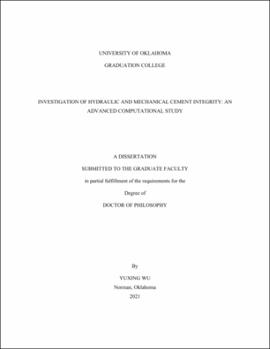| dc.description.abstract | Cement sheath is a significant barrier to maintain the zonal isolation of wells, preventing severe consequences such as kick (or influx) accidents, environmental contaminations, and safety threats. Many previous investigations have assessed the performance of cement via experimental and analytical studies based on several setups. However, further advanced studies should be conducted to solve the severe challenges posed by the increased exploration activities in harsh operational environments and advanced stimulation in long lateral wells.
To achieve this goal, mechanical and hydraulic cement integrity considerations should be involved during the analysis. Mechanical considerations should satisfy the requirements of structural failure prevention in the cement under different wellbore conditions, such as high-temperature high-pressure (HTHP). Hydraulic integrity needs quality evaluations of cement slurry. This dissertation aims to evaluate cement quality by analyzing the mechanical stresses around the set cement and the fluid mechanics in the cement displacement processes using a numerical approach. The specific objectives are to (i) investigate the performance of cement under various designs, operations, and loading conditions, (ii) identify the influencing parameters which affect the cement performance, and (iii) evaluate the influence of enlarged wellbore on the mud displacement efficiency via a numerical approach.
Diametric compression simulation indicates that cement sheath is likely to fail at the casing interface before the formation interface. Along with the casing-cement interface, failure would initiate at the location parallel to the direction of applied load (θ = 0°). High hoop stresses exceeding the limiting strength are the primary cause of the cement failure. HTHP wellbore conditions have a significant influence on cement integrity due to high thermal loads. Heat flow direction away from the wellbore (ΔT >0) generates approximately 65% higher magnitudes of radial and hoop stresses in the cement sheath compared to heat flow direction toward the wellbore (ΔT <0). Sensitivity analysis indicates that regardless of the heat transfer direction, radial and hoop stresses in cement have a higher sensitivity to temperature changes than internal pressure load. For heat flow toward the wellbore (ΔT <0), temperature difference, internal casing pressure, and in-situ horizontal stresses are three main predictors of stresses in cement. For heat flow toward the formation (ΔT >0), there is no precise predictor of stresses in cement. Radial stress primarily depends on temperature difference and internal casing pressure, followed by the cement’s Young’s modulus and in-situ stresses. On the other hand, Hoop stress mainly depends on the cement’s Young’s modulus and Poisson’s ratio, followed by temperature difference and in-situ stress. For the cement hydraulic integrity study, an incomplete mud removal has a high risk of occurring at the top of the annulus.
Technical novel information of this research is to (i) investigate the performance of different cement under subsurface conditions by an experimentally validated finite element analysis (FEA) model, (ii) use the casing-cement-formation system to represent a more realistic wellbore condition, and (iii) study the influence of fluid dynamics during mud removal. | en_US |
